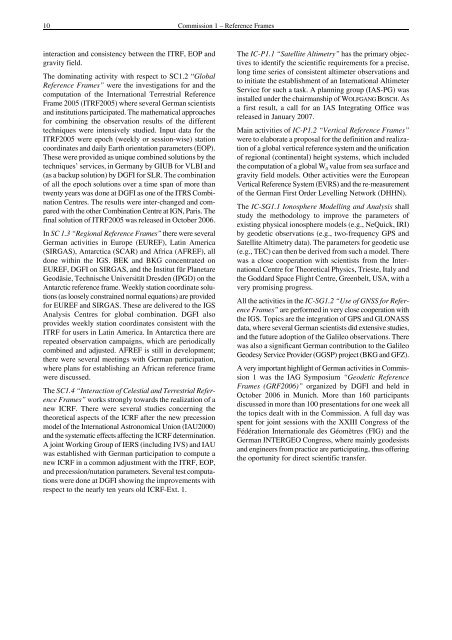NATIONAL REPORT OF THE FEDERAL REPUBLIC OF ... - IAG Office
NATIONAL REPORT OF THE FEDERAL REPUBLIC OF ... - IAG Office
NATIONAL REPORT OF THE FEDERAL REPUBLIC OF ... - IAG Office
Create successful ePaper yourself
Turn your PDF publications into a flip-book with our unique Google optimized e-Paper software.
10 Commission 1 – Reference Frames<br />
interaction and consistency between the ITRF, EOP and<br />
gravity field.<br />
The dominating activity with respect to SC1.2 “Global<br />
Reference Frames” were the investigations for and the<br />
computation of the International Terrestrial Reference<br />
Frame 2005 (ITRF2005) where several German scientists<br />
and institutions participated. The mathematical approaches<br />
for combining the observation results of the different<br />
techniques were intensively studied. Input data for the<br />
ITRF2005 were epoch (weekly or session-wise) station<br />
coordinates and daily Earth orientation parameters (EOP).<br />
These were provided as unique combined solutions by the<br />
techniques’ services, in Germany by GIUB for VLBI and<br />
(as a backup solution) by DGFI for SLR. The combination<br />
of all the epoch solutions over a time span of more than<br />
twenty years was done at DGFI as one of the ITRS Combination<br />
Centres. The results were inter-changed and compared<br />
with the other Combination Centre at IGN, Paris. The<br />
final solution of ITRF2005 was released in October 2006.<br />
In SC 1.3 “Regional Reference Frames” there were several<br />
German activities in Europe (EUREF), Latin America<br />
(SIRGAS), Antarctica (SCAR) and Africa (AFREF), all<br />
done within the IGS. BEK and BKG concentrated on<br />
EUREF, DGFI on SIRGAS, and the Institut für Planetare<br />
Geodäsie, Technische Universität Dresden (IPGD) on the<br />
Antarctic reference frame. Weekly station coordinate solutions<br />
(as loosely constrained normal equations) are provided<br />
for EUREF and SIRGAS. These are delivered to the IGS<br />
Analysis Centres for global combination. DGFI also<br />
provides weekly station coordinates consistent with the<br />
ITRF for users in Latin America. In Antarctica there are<br />
repeated observation campaigns, which are periodically<br />
combined and adjusted. AFREF is still in development;<br />
there were several meetings with German participation,<br />
where plans for establishing an African reference frame<br />
were discussed.<br />
The SC1.4 “Interaction of Celestial and Terrestrial Reference<br />
Frames” works strongly towards the realization of a<br />
new ICRF. There were several studies concerning the<br />
theoretical aspects of the ICRF after the new precession<br />
model of the International Astronomical Union (IAU2000)<br />
and the systematic effects affecting the ICRF determination.<br />
A joint Working Group of IERS (including IVS) and IAU<br />
was established with German participation to compute a<br />
new ICRF in a common adjustment with the ITRF, EOP,<br />
and precession/nutation parameters. Several test computations<br />
were done at DGFI showing the improvements with<br />
respect to the nearly ten years old ICRF-Ext. 1.<br />
The IC-P1.1 “Satellite Altimetry” has the primary objectives<br />
to identify the scientific requirements for a precise,<br />
long time series of consistent altimeter observations and<br />
to initiate the establishment of an International Altimeter<br />
Service for such a task. A planning group (IAS-PG) was<br />
installed under the chairmanship of WOLFGANG BOSCH. As<br />
a first result, a call for an IAS Integrating <strong>Office</strong> was<br />
released in January 2007.<br />
Main activities of IC-P1.2 “Vertical Reference Frames”<br />
were to elaborate a proposal for the definition and realization<br />
of a global vertical reference system and the unification<br />
of regional (continental) height systems, which included<br />
the computation of a global W0 value from sea surface and<br />
gravity field models. Other activities were the European<br />
Vertical Reference System (EVRS) and the re-measurement<br />
of the German First Order Levelling Network (DHHN).<br />
The IC-SG1.1 Ionosphere Modelling and Analysis shall<br />
study the methodology to improve the parameters of<br />
existing physical ionosphere models (e.g., NeQuick, IRI)<br />
by geodetic observations (e.g., two-frequency GPS and<br />
Satellite Altimetry data). The parameters for geodetic use<br />
(e.g., TEC) can then be derived from such a model. There<br />
was a close cooperation with scientists from the International<br />
Centre for Theoretical Physics, Trieste, Italy and<br />
the Goddard Space Flight Centre, Greenbelt, USA, with a<br />
very promising progress.<br />
All the activities in the IC-SG1.2 “Use of GNSS for Reference<br />
Frames” are performed in very close cooperation with<br />
the IGS. Topics are the integration of GPS and GLONASS<br />
data, where several German scientists did extensive studies,<br />
and the future adoption of the Galileo observations. There<br />
was also a significant German contribution to the Galileo<br />
Geodesy Service Provider (GGSP) project (BKG and GFZ).<br />
A very important highlight of German activities in Commission<br />
1 was the <strong>IAG</strong> Symposium “Geodetic Reference<br />
Frames (GRF2006)” organized by DGFI and held in<br />
October 2006 in Munich. More than 160 participants<br />
discussed in more than 100 presentations for one week all<br />
the topics dealt with in the Commission. A full day was<br />
spent for joint sessions with the XXIII Congress of the<br />
Fédération Internationale des Géomètres (FIG) and the<br />
German INTERGEO Congress, where mainly geodesists<br />
and engineers from practice are participating, thus offering<br />
the oportunity for direct scientific transfer.











